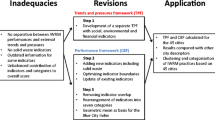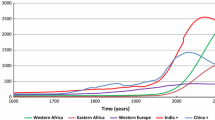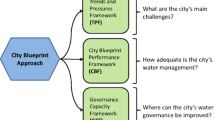Abstract
Measuring performance and setting targets and benchmarks for the future entail the adoption of metrics or indicators. Sustainability is a multi-pronged objective encompassing social, economic, health, cultural, governance and environmental aspects. Indicators can be grouped under these categories. The selection of environmental sustainability indicators for a water and wastewater utility in a city needs to be based on concerns specific to the utility in question. The authors, in this paper, have recommended the classification of cities into city types based on specific attributes and identification of relevant environmental sustainability indicators, from a pool of 13 indicators, for these different city types. Having selected the relevant indicators, utilities can use them as tools to improve their environmental performance. The purpose is to not facilitate inter-utility comparisons within or across city types. Every utility would compare its environmental performance at a given point in time with what it was in the past. Towards the end, the paper also applies the methodology to nine cities across four continents—Europe (Oslo, Trondheim and Turin), Asia (the National Capital Territory of Delhi, Beijing, Tel Aviv and Male), North America (Sacramento) and South America (São Paulo). In all, 13 environmental sustainability indicators have been identified. Two cities—Oslo and Trondheim (both from Norway) belong to the same city type, while the other seven are different from each other in this regard. The number of relevant indicators ranged from 4 for Trondheim to 11 for Tel Aviv. The methodology is not restricted to urban water supply and sewage handling systems. It can be extended to other infrastructure systems as well—waste management, transportation, etc.


Similar content being viewed by others
References
Cabrera, E. (2008). Benchmarking in the water industry: A mature practice? WaterUtility Management International, 3(3), 5–7.
Dale, L. (2012). Economist at Lawrence Berkeley National Laboratory, California, USA. Personal communication in March.
Elmi, R. A., Johnsen, O. J., & Oslo, V. A. V. (2012). Oslo, Norway. Personal communication in January.
Flores, A., Buckley, C., & Fenner, R. (2009). Selecting sanitation systems for sustainability in developing countries. Water Science and Technology, 60(11), 2973–2982.
Foxon, T. J., McIlkenny, G., Gilmour, D., Oltean-Dumbrava, C., Souter, N., Ashley, R., et al. (2002). Sustainability criteria for decision support in the UK water industry. Journal of Environmental Planning and Management, 45(2), 285–301.
Funamizu, N., Iida, M., Sakakura, Y., & Takakuwa, T. (2000). Reuse of heat energy in wastewater: Implementation examples in Japan. Water Science and Technology, 43(10), 277–285.
Guiseppe, G. (2012). Professor: Politecnico di Torino, Turin, Italy. Personal communication in February.
Hellstroem, D., Jeppsson, U., & Kaerrman, E. (2000). A framework for systems analysis of sustainable urban water management. Environmental Impact Assessment Review, 20(3), 311–321.
Kansal, A. (2012). Associate Professor at Department of Natural Resources. TERI, New Delhi (India). Personal communication in March.
Keirstead, J., & Leach, M. (2008). Bridging the gaps between theory and practice: A service niche approach to urban sustainability indicators. Sustainable Development, 16(5), 329–340.
Lindholm, O. G., & Nordeide, T. (2000). Relevance of some criteria for sustainability in a project for disconnecting of storm run-off. Environmental Impact Assessment Review, 20(3), 413–423.
Lundin, M., Molander, S., & Morrison, G. M. (1999). A set of indicators for the assessment of temporal variations in the sustainability of sanitary systems. Water Science and Technology, 39(5), 235–242.
Lundin, M., & Morrison, G. M. (2002). A life cycle assessment based procedure for development of environmental sustainability indicators for urban water systems. Urban Water, 4(2), 145–152.
Malmqvist, P. A., & Palmquist, H. (2005). Decision-support tools for urban water and wastewater systems: Focusing on hazardous flow assessments. Water Science and Technology, 51(8), 41–49.
Matos, R., Cardoso, A., Duarte, P., Ashley, R., Molinari, A., & Schulz, A. (2003). Performance indicators for wastewater services: Towards a manual of best practice. Water Science and Technology Water Supply, 3(1–2), 365–371.
Mitchell, G. (1996). Problems and fundamentals of sustainable development indicators. Sustainable Development, 4(1), 1–11.
Mujthaba, A. (2012). Operations manager, male water and sewerage company. Male, Maldives. Personal communication in February.
Opher, T. (2012). Doctoral researcher, Department of Environmental, Water and Agricultural Engineering, Faculty of Civil and Environmental Engineering, Technion- Israel Institute of Technology, Tel Aviv, Israel. Personal communication in February.
Palme, U., Lundin, M., Tillman, A.-M., & Molander, S. (2005). Sustainable development indicators for wastewater systems: Researchers and indicator users in a cooperative case study. Resources, Conservation and Recycling, 43(3), 293–311.
Pei, L. (2012). Institute of Geographical Sciences and Natural Resources Research. Chinese Academy of Sciences, Beijing. Personal communication in March.
Ricardo, M. (2012). Federal University of Itajuba, Brazil. Personal communication in March.
Sahely, H. R., & Kennedy, C. A. (2007). Water use model for quantifying environmental and economic sustainability indicators. Journal of Water Resources Planning and Management, 133(6), 550–559.
Singhirunnusorn, W., & Stenstrom, M. K. (2009). Appropriate wastewater treatment systems for developing countries: Criteria and indicator assessment in Thailand. Water Science and Technology, 59(9), 1873–1884.
Slagstad, H. (2012). Doctoral researcher, Norwegian University of Science and Technology, Trondheim, Norway. Personal communication in January.
Starkl, M., Brunner, N., Grasser, U., Moog, O., Stagl, S., Kaerman, E., et al. (2005). Analysis and evaluation of methodologies to assess technical urban water systems. Water Science and Technology, 52(9), 43–51.
Tenne, A. (2010). Seawater desalination in Israel: Planning, coping with difficulties and economic aspects of long-term risks. Water authority: State of Israel—desalination division. Accessed at http://www.water.gov.il/Hebrew/Planning-and-Development/Desalination/Documents/Desalination-in-Israel.pdf, in February 2012.
The Advanced Water Asset Rehabilitation, Portugal—EU Project. (2011). http://www.aware-p.org/np4/approach/. Accessed in September.
The China Daily. (2012a). Water shortage in Beijing severe. Accessed at http://www.chinadaily.com.cn/opinion/2012-01/05/content_14384093.htm, in March 2012.
The China Daily. (2011). Beijing to fight water scarcity. Accessed at http://www.chinadaily.com.cn/china/2011-10/08/content_13851695.htm, in March 2012.
The China Daily. (2012b). Beijing urban area to halt underground water extraction. Accessed at http://europe.chinadaily.com.cn/china/2012-02/28/content_14707333.htm, in March 2012.
The International Benchmarking Network for Water and Sanitation Utilities. (2011). Webpage: u. Accessed in October.
Venkatesh, G., & Brattebo, H. (2011). Energy consumption, costs and environmental impacts for urban water cycle services: Case study of Oslo (Norway). Energy, 36(2), 792–800.
Venkatesh, G. & Brattebo, H. (2012a). Assessment of environmental impacts of an ageing and saturated water supply pipeline network: City of Oslo, 1991-2006. Accepted for publication in the Journal of Industrial Ecology.
Venkatesh, G., & Brattebø, H. (2011). Environmental impact analysis of chemicals and energy consumption in wastewater treatment plants: Case study of Oslo, Norway. Water Science and Technology, 63(5), 1018–1031.
Venkatesh, G., & Brattebø, H. (2012). Environmental impact analysis of chemicals and energy consumption in water treatment plants: Case study of Oslo, Norway. Water Science and Technology-Water Supply, 12(2), 200–211.
Venkatesh, G., Didi, M. A., & Mujthaba, A. (2011). Male makes the most of limited land and freshwater. Journal of American Water Works Association, 103(5), 44–50.
Venkatesh, G., Hammervold, J., & Brattebø, H. (2009). Combined MFA-LCA of wastewater pipeline networks: Case study of Oslo (Norway). Journal of Industrial Ecology, 13(4), 532–550.
Venkatesh, G., & Ugarelli, R. (2010). Oslo consumers willing to pay more for improved services: Interview with Per Kristiansen, Chief of Oslo VAV. Journal of the American Water Works Association, 102(11), 26–29.
Yepes, G. & Dianderas, A. (1996). Water and wastewater utilities: Indicators 2nd edition,’ Water and Sanitation Division—World Bank, page 1.
Zakkour, P. D., Gaterell, M. R., Griffin, P., Gochin, R. J., & Lester, J. N. (2002). Developing a sustainable energy strategy for a water utility. Part II: a review of potential technologies and approaches. Journal of Environmental Management, 66, 115–125.
Acknowledgments
Thanks to Helene Slagstad and Matthieu Vachon of NTNU for their inputs on Trondheim and Nantes, respectively. Thanks to Rashid Abdi Elmi and Ole Jakob Johnsen of Oslo Water and Wastewater Authority, Prof. Genon Guiseppe of the Polytechnic of Turin for his inputs on Turin (Italy), Tamar Opher of Technion, Tel Aviv, for inputs on Tel Aviv, Thomas Hendrickson for sharing information about cities in the USA (which have not been included in this paper though), Larry Dale of the Lawrence Berkeley Laboratory in California for his inputs on Sacramento, Prof. Arun Kansal of TERI, New Delhi, Mateus Ricardo of the University of Ijatuba, Brazil, Ahmed Mujthaba for his inputs on Male (Maldives), Dr Liang Pei of the Institute of Geographical Sciences and Natural Resources Research, Chinese Academy of Sciences, for the information about Beijing (and Gang Liu of NTNU, Trondheim for enabling me to contact Dr Liang). Thanks to the reviewers for their constructive comments which have helped to improve this paper.
Author information
Authors and Affiliations
Corresponding author
Appendix
Appendix
See Table 3.
Rights and permissions
About this article
Cite this article
Venkatesh, G., Brattebø, H. Typifying cities to streamline the selection of relevant environmental sustainability indicators for urban water supply and sewage handling systems: a recommendation. Environ Dev Sustain 15, 765–782 (2013). https://doi.org/10.1007/s10668-012-9405-1
Received:
Accepted:
Published:
Issue Date:
DOI: https://doi.org/10.1007/s10668-012-9405-1




